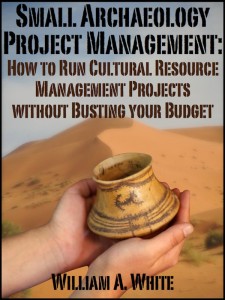“Things don’t just work out right. We have to make things work out right.” Nido Qubien
I got my first job in archaeology in 2004. I was a crew chief working for the Idaho Transportation Department on a project in Lewis County, near Lenore, Idaho. Because I was a grad student and had attended field school, I was given control of a small excavation crew. My only instructions were to make sure everyone filled out their paperwork correctly (but, I wasn’t given an example of a correctly filled out field form) and to make sure nobody got hurt.
I worked on that project for about 8 months. Evidentially, our field forms were good enough to write up a report and for another grad student to get a thesis out of it. People did get hurt, but not life-threateningly. We broke several OSHA regulations, including digging way deeper than the legal limit and almost rolling a small backhoe into the excavation. It was hard work that was punctuated by mishap after mishap, accident after accident, and mistake after mistake. It’s a miracle the project ended as well as it did.
I learned from those mistakes and walked away from it unscathed, but always remember thinking about how little guidance I’d received from my university education and wondering if all archaeology projects were ran that way.
Nine years later, not much has changed in cultural resource management:
- We still don’t receive much training on cultural resource management project supervision or field methods.
- Few supervisors take the time to give specific instructions.
- A “sink or swim” mentality permeates our industry and new CRMers are dropped into the deep end right off the bat.
- University professors (despite their intelligence and dedication) do not have the time and/or experience to prepare each student for the world of cultural resource management, historic preservation, or heritage conservation.
- Few companies realize how much money is wasted on unprepared field technicians, crew chiefs, and project directors.
I know how hard it was for me to learn how to finish a project on time and on budget. I still make mistakes and, occasionally, have cost overruns, but not like I did when I first started out.
Working in cultural resource management, heritage conservation, or historic preservation is hard work. Finding a job is hard enough (click here to see some information on how you can land a job in archaeology). Keeping a job is even harder when you have such a steep learning curve.
I don’t think it has to be this way. I think you archaeologists, architectural historians, and heritage conservation professionals are smart enough to learn how to manage projects of all sizes without having to go through years of pain and anguish that your predecessors went through. You can learn from our mistakes and start off successfully from the get-go.
Small projects are the lifeblood of our industry. They’re also particularly difficult to successfully manage because they have such a small margin of error. Since most of us start off managing small projects, we need to use each of these to hone our skills and learn what it takes to manage the larger ones that will come later in our careers.
That’s why I wrote a book about small archaeology project management. I want to help every up-and-coming CRM crew chief and project manager. I also wanted to provide tips that those of us that have been in this field for years can use to make our work more efficient and profitable.
The Small Archaeology Project Management eBook is based on the tips and tricks of the trade that I’ve collected over nearly a decade of CRM project management. The book was edited and commented on by other CRMers from Seattle to Reno to Boston. It is a step-by-step template that dozens of CRMers across the United States use to complete small projects on time and on budget.
Above all, I wanted to make the book portable and affordable. That’s why it will be sold through the Amazon eBookstore. There aren’t many other CRM project management books that you can download to your phone and use in your hotel room or in the field. This book will be a first of many portable, affordable eBooks published by Succinct Research.
The book will be available on the Amazon Kindle eBookstore on March 1, 2013. Keep reading the blog for excerpts and more project management tips.
I would really love to hear from you. If you have any questions or comments, write below or send me an email.
Learn how my résumé-writing knowledge helped four of my fellow archaeologists land cultural resources jobs in a single week!
Join the Succinct Research email list and receive additional information on the CRM and heritage conservation field.




Is it possible to get to book in a hard copy format? I don’t have a kindle and don’t read off my phone. ~ Thanks.
Sorry Patricia, the books are only on kindle. You can download a free kindle reader for PC or Mac and read it on your computer/tablet http://www.amazon.com/gp/feature.html/ref=kcp_pc_mkt_lnd?docId=1000426311
I’ve decided to only publish digitally because its easier to share and can always be read anywhere you have a device. The goal is to make these books more accessible and portable while also cutting down on natural resource uses. It may cost me a couple sales, but i believe digital publishing is the future of archaeological literature.
Thanks for reading. Keep in touch.